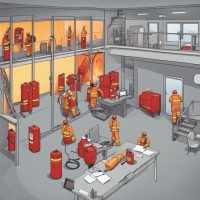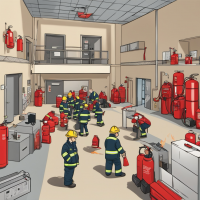
Conducting a fire risk assessment is a critical step in ensuring the safety of a building and its occupants. However, the assessment alone is not enough. What truly makes a difference is the creation and implementation of a comprehensive action plan that addresses the findings. A well-crafted action plan turns insights into action, reduces hazards, ensures legal compliance, and enhances overall fire safety preparedness.
In this article, we’ll walk through the essential steps for creating an effective action plan after a fire risk assessment.
- Review and Understand the Fire Risk Assessment Report
The first step is to thoroughly review the fire risk assessment report. Whether conducted by a professional fire safety assessor or a trained internal team member, the report will outline potential fire hazards, identify people at risk, evaluate existing fire safety measures, and provide recommendations for improvement.
Key things to look for:- Areas with significant fire hazards (e.g., faulty wiring, flammable materials)
- Inadequate fire detection or suppression systems
- Emergency exit accessibility issues
- Gaps in staff training or evacuation procedures
- Legal compliance issues
Understanding the severity and urgency of each finding helps prioritize what needs to be addressed first.
- Categorize the Identified Risks
Next, classify each issue from the assessment based on its:- Severity (High, Medium, Low)
- Likelihood of occurrence
- Potential impact on people, property, and operations
By doing this, you can begin to structure your plan around high-risk areas that pose immediate danger and require prompt action.
- Set Clear, Measurable Objectives
An action plan should outline what you aim to achieve, not just what needs fixing. Objectives should be:- Specific (e.g., install fire extinguishers in all hallways)
- Measurable (e.g., reduce blocked emergency exits to zero within 30 days)
- Achievable (within the limits of your budget and resources)
- Relevant (aligned with legal and safety requirements)
- Time-bound (set deadlines for completion)
This SMART framework helps ensure that each action is goal-oriented and trackable.
- Assign Responsibilities
For each action, clearly assign a responsible person or team. Fire safety is a shared responsibility, but assigning accountability prevents tasks from falling through the cracks.
Include:- Who will carry out the action (e.g., Facilities Manager, Safety Officer)
- Who will oversee implementation and progress
- Who will verify completion
This accountability system encourages proactive follow-through.
- Develop a Realistic Timeline
Set out a timeline for each action based on priority. High-risk hazards should be addressed immediately or within a short-term window (e.g., 1–7 days), while medium to low-risk items can be scheduled over a longer period.
Your timeline should be:- Prioritized according to risk level
- Flexible enough to accommodate unforeseen delays
- Reviewed periodically and updated as needed
Use project management tools or spreadsheets to visually track progress and deadlines.
- Allocate Resources and Budget
Every corrective action will likely require some combination of time, manpower, or money. Allocate the necessary resources to implement each measure effectively.
Consider:- Costs of equipment (e.g., fire extinguishers, alarms)
- Contractor or specialist fees
- Staff training programs
- Internal labor hours
Include these details in the action plan to support funding requests and prevent implementation delays.
- Implement the Action Plan
Begin executing your plan in accordance with the timeline and assigned responsibilities. Communication is key—ensure that all involved parties understand the plan, the reasons behind it, and their specific roles.
Best practices:- Hold regular update meetings
- Use a central dashboard to track progress
- Encourage open feedback to identify roadblocks early
Continual coordination helps keep the plan on track.
- 8. Monitor Progress and Maintain Documentation
Track the implementation of each step and document progress. This not only keeps the plan organized but also provides evidence of compliance and diligence if inspected by fire authorities.
Record:- Completion dates
- Evidence (photos, purchase receipts, inspection logs)
- Notes on challenges or changes to the original plan
Documentation is vital for audits, insurance, and future risk assessments.
- Conduct a Follow-up Fire Risk Assessment
Once the action plan has been largely implemented, schedule a follow-up fire risk assessment. This step validates whether the actions taken have successfully mitigated the risks and helps identify any remaining gaps.
Even if everything appears to be completed, having a fresh assessment ensures your efforts align with current regulations and best practices. - Maintain Ongoing Fire Safety Management
Creating a one-time action plan isn’t enough. Fire safety is an ongoing process. Regular maintenance, training, and reassessments are crucial.
Ongoing activities might include:- Monthly fire equipment checks
- Annual fire drills
- Refresher training for employees
- Updated evacuation signage
- Revising the action plan after structural or operational changes
By embedding fire safety into your organizational culture, you reduce future risks and ensure long-term compliance.
Conclusion
Creating an action plan after a fire risk assessment is essential to closing the loop between identifying hazards and resolving them. It transforms potential liabilities into opportunities for improvement and ultimately protects lives, property, and operations. Whether you’re managing a residential building, commercial property, or industrial site, a well-executed action plan is your blueprint for lasting fire safety.
With clarity, commitment, and coordination, you can move from risk to readiness—one action step at a time.





Leave A Comment